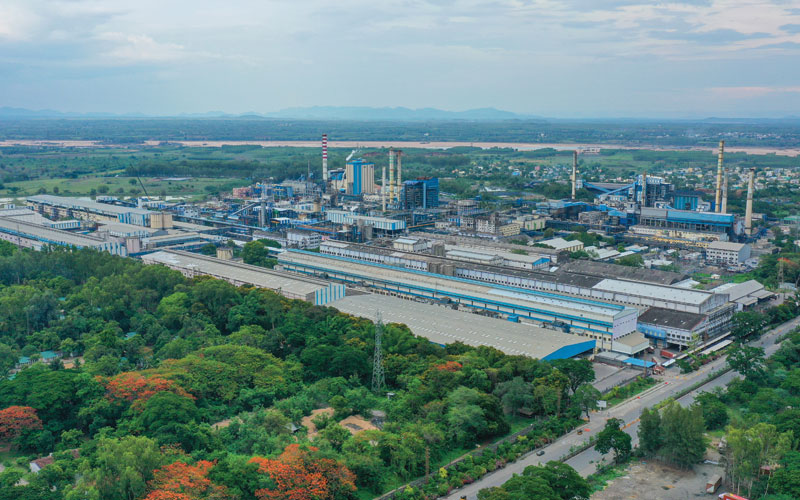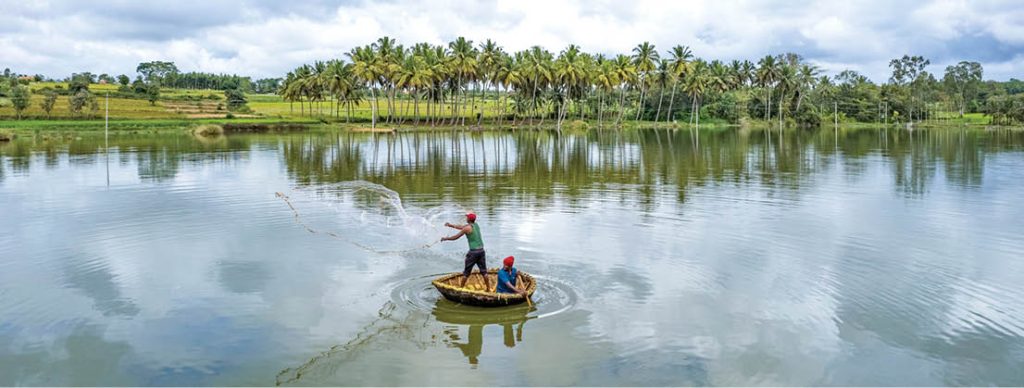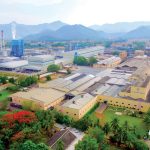ITC- Paperboards & Specialty Papers Division has been a water-positive company for 23 years in a row, with internal water reuse levels reaching over 80% in some of its mills, driven by the adoption of closed-loop systems and advanced treatment technologies. The company has reduced its freshwater intake per ton of product by 28% and repurposed 40% of treated effluent for irrigation purposes. Its Bhadrachalam and Kovai units have been awarded the AWS Platinum ratings, setting benchmarks in water circularity. Over time, the mills have shifted their emphasis from compliance to proactive and forward-looking goals in water management, driven by the larger organizational focus on Sustainability 2.0—empowering ITC to stay ahead and be future-ready in its environmental commitments.

Paper Mart: How has your understanding or approach to water circularity evolved over time? How close are you to achieving it?
ITC PSPD: Over time, our perspective and approach on water has evolved. From a compliance focus in the initial years, the emphasis has now shifted to proactive actions and efficiency drivers, recognizing water not just as an input, but as a valuable resource that must be reused and optimized through every stage of operations.
This shift, in approach and focus, is driven not just in the manufacturing operations, but extended throughout our value chain. Today, we integrate water circularity across all phases of our processes — from raw material handling to effluent treatment. This includes the adoption of closed-loop systems, advanced filtration and recycling technologies, and efficient heat and water recovery solutions that significantly reduce freshwater intake.
Our operations have already achieved optimum levels of water reuse, up to 80% in some mills. However, full circularity goes beyond internal efficiency. It also requires alignment with local watershed sustainability and active engagement with external stakeholders to ensure broader environmental impact.
Our company’s extensive rainwater harvesting initiatives in the local catchment areas across our factories have resulted in a rain water harvesting potential that is about 4 times the water consumption by our factories.
ITC is a water-positive company for 23 years in a row. Our units Bhadrachalam & Kovai have been awarded the “Alliance for Water Stewardship” (AWS) Platinum rating – the highest global recognition for water stewardship initiatives. AWS certification is widely regarded as the gold standard for responsible water use and sustainable watershed management at the international level. These recognitions stand testimony to the organizational commitment and result-oriented initiatives being driven. All our factories have set benchmarks in water circularity and would continuously strive to raise the bar continuously.
Watch: In Pursuit of Lesser Water Footprint
PM: To what extent have you implemented internal water reuse, recovery, or circular systems (including ZLD, water loop closure, or rainwater harvesting)?
ITC: Our operations have achieved significant progress in implementing circular water systems. Internal water reuse levels have reached over 80% in some of our mills, driven by adoption of closed loop systems and advanced treatment technologies. In addition, more than 40% of treated effluent is repurposed for irrigation purposes within the local catchment area, contributing to community water resilience and reducing fresh water dependency. These initiatives are part of our broader commitment to sustainable water management and environmental stewardship.
PM: Which technologies or solutions have you found most effective in reducing your freshwater consumption or increasing internal recycling?
ITC: Closed-loop water systems have been instrumental in significantly reducing freshwater intake across our facility. By recirculating process water within the mill, we have ensured not only water resource efficiency but also consistent water quality, which is crucial for paper machine operations.
A key initiative in this regard is the implementation of white water save-all systems that recover and reuse water effectively. In addition, treated effluent is recycled for use in showers, further minimizing the need for fresh water.
We have also leveraged excess hot water generated in the pulp mill by channeling it back into the paper machine. Similarly, backwater from the paper machine is now reused for pulp dilution, reducing the demand for fresh input water.
Our water conservation efforts extend to optimizing shower systems by minimizing nozzle sizes, without impacting the cleaning performance. Additionally, pump sealing water has been closed-looped wherever feasible along with usage of dry mechanical seals. We have also improved condensate recovery from paper machines and evaporators with process control systems and advanced technology.
We use membrane filtration technologies such as ultrafiltration and reverse osmosis that enable us to treat and reuse process water at high purity levels, enabling it to be reused in critical operations like pulp washing and chemical recovery. Our adoption of IoT-based sensors and AI-driven analytics has further enabled proactive water quality control, early detection of process inefficiencies, and dynamic reuse routing.
Process optimization has also played a key role in water conservation. The implementation of a single bleaching line and improved pulp washing systems has reduced the initial water demand during pulping, thereby easing the burden on downstream treatment systems. In the cooling systems, we have replaced liquid ring vacuum pumps with turbo blowers to reduce evaporation losses and the need for fresh water makeup. Moreover, treated effluent is now being utilized in cooling towers, further cutting down on the use of freshwater resources.

Our mill has commissioned a BCTMP (Bleached Chemi-Thermo Mechanical Pulp) mill designed for zero liquid discharge (ZLD), contributing to our water conservation efforts.
PM: What are the biggest roadblocks (technical, financial, or regulatory) in achieving higher levels of water reuse or moving toward ZLD?
ITC: One of the challenges due to the increased recycling of water is an increase of Total Dissolved Solids (TDS) in the effluent discharged. This entails additional investments in emerging technologies like evaporators and Agitated Thin Film Dryers (ATFD) in addition to existing effluent treatment facilities like Moving bed biofilm reactor (MMBR), Diffused Aeration system (DAS) and membrane technologies (ultra filtration and reverse osmosis), aimed to limit the TDS levels in effluent, in line with the prevailing norms.
These investment demands constrain the competitiveness of the industry vis-à-vis the global players. Beside these, energy intensive investments also lead to increased CO2 emissions.
PM: How do local or national regulations affect your water management goals? Have sustainability mandates accelerated your water-saving initiatives?
ITC: The prevailing local and national regulations provide a strong basis and baseline for all the water management initiatives. As mentioned above, over time, our mills have shifted the emphasis from compliances to proactive and forward-looking goals in water management.
This, driven by the larger organizational emphasis on Sustainability 2.0 as a key business driver, triggered multiple initiatives and projects that aided our journey in being future-ready.
Embracing global standards like Alliance for Water Stewardship (AWS) not only aided in pushing our performance boundaries beyond the past benchmarks but also provided an outside-in perspective in transforming the orientation and mindset of our operating teams in approaching water management. This cultural shift not only results in short term new benchmark outcomes but also ensures sustenance of the processes and outcomes.

PM: Have your investments in water reuse or ZLD technologies paid off in terms of savings, efficiency, or compliance?
ITC: Our organizational commitment towards water management initiatives is driven by future-ready goals and proactive initiatives that aim for outcomes beyond compliance requirements. These initiatives are implemented by leveraging the engineering and process expertise that is organically built, thus ensuring that the financial returns too are delivered while meeting the water management goals.
This is in line with the ‘triple bottom line’ philosophy that ITC embodies in all its business operations. Our mills have been able to enhance the production capacity significantly over time without the need for additional water infrastructure or increased water consumption. Further, these initiatives have resulted in significant improvement in various parameters like water efficiencies, effluent treatment costs and energy efficiency, which are over and above the compliance demands.

Full circularity in water reuse goes beyond internal efficiency, requiring alignment with local watershed sustainability and active engagement with external stakeholders to ensure broader environmental impact.

PM: Do you involve technology providers in planning or customizing your water treatment systems? Any successful collaborations worth sharing?
ITC: The organizational approach towards driving a critical change management process, emphasises on co-creation and partnerships with all stakeholders, both internal and external, in developing solutions that offer both short-term and long-term outcomes.
Our mills actively collaborate with technology providers, industry consultants, and original equipment manufacturers (OEMs) in assessing, evaluating, and recommending opportunities to improve water use efficiency. Their expertise is critical in developing customized solutions aligned with specific mill processes, water quality requirements, and regulatory standards. A few examples are listed below:
Water Pinch Analysis (WPA) with CII: Our mills have conducted a detailed Water Pinch Analysis (WPA) in collaboration with the Confederation of Indian Industry (CII). This is a systematic approach used to optimize water usage and minimize wastewater generation in industrial processes. Based on integrating water-consuming and water-generating activities, this analysis helped us identify approximately 5,000 m³ per day of potential water savings.
Upgradation of Pulp Bleaching Process: In collaboration with the technology provider, our mills have upgraded our pulp bleaching process, implementing closed-loop systems across various bleaching stages. This has significantly reduced water usage in our pulp manufacturing operations.
BCTMP: Our mill has commissioned a BCTMP (Bleached Chemi-Thermo Mechanical Pulp) mill designed for zero liquid discharge (ZLD) and installed a state-of-the-art evaporator to enhance condensate recovery, contributing further to our water conservation efforts.

Our mills have conducted a detailed Water Pinch Analysis (WPA) in collaboration with the Confederation of Indian Industry (CII) to optimize water usage and minimize wastewater generation in industrial processes. This analysis helped us identify approximately 5,000 m³ per day of potential water savings.
PM: How do you see your water use evolving in the next 5–10 years? What would “full circularity” look like in your operations? What kinds of support in terms of technology, partnerships, or policies would help you get there?
ITC: Over the next 5–10 years, we envision a significant transformation in our water use practices, moving towards a closed-loop system by adopting best available technologies. This approach will ensure that the treated effluent is reused, recovered, or repurposed.
Our objective is to further reduce freshwater intake through implementation of water recycling, advanced treatment technologies, and deployment of digital tools for real-time water monitoring and management, aligned with global benchmarks.
To achieve this vision, we foresee strong potential in the technology, partnerships, and policy support aspects. In terms of technology, we envision continued evolution in membrane technologies, low-energy treatment systems, and AI-driven water analytics. We look forward to collaborating with technology providers, academic institutions, and water stewardship organizations for innovation and knowledge sharing. For policy support, we expect clear, forward-thinking regulations that recognize and incentivize water-positive practices, streamline permitting for reuse projects, and support industry-level collaboration.
Also Read: JK Paper Leverages Advanced Technologies to Reduce 19% Water Consumption in 2 Years
PM: Have you considered or implemented digital twins to simulate, monitor, or optimize your water use? What kind of improvements could such systems bring to your operations?
ITC: Digital innovations and sustainability are the two key levers ITC leverages to drive enhanced business results, with water management being a core focus area at their intersection.
We have invested in digital systems like Industry 4.0 tools and data analytics in partnerships with industry experts to provide valuable insights that support effective water management. Using these platforms, we have built dashboards for paper machine white water towers to monitor and optimize water usage in pulp dilution. Further, we have developed data-driven models for steam turbine operations. These models enable optimized loading of turbines for power generation, and help minimize evaporation losses in turbine cooling towers.
Overall, these digital tools have significantly improved operational efficiency and enabled proactive decision making in water management. The same emphasis shall be sustained and strengthened going forward too.
PM: What is your current annual water consumption, and how has the consumption reduced over the past few years?
ITC: Over the past decade, our company has made significant progress in enhancing water use efficiency. We have successfully reduced our freshwater intake per ton of product by 28%. This achievement is the result of sustained efforts in process optimization, water recycling & reuse initiatives. Further, we have increased the reuse rate of treated effluent to 53% by adopting various initiatives both within and beyond the fence.



